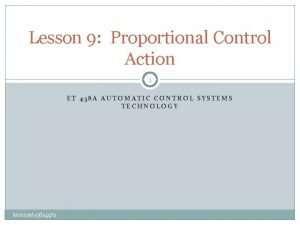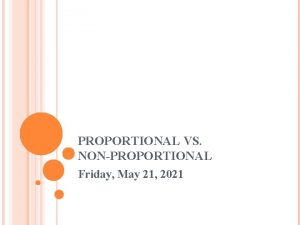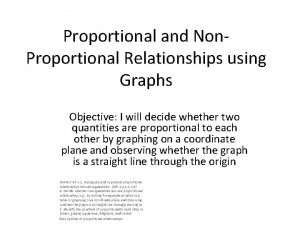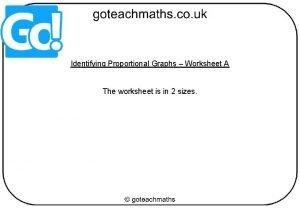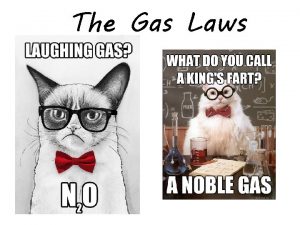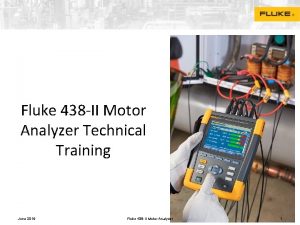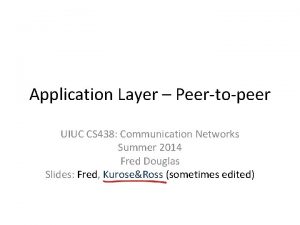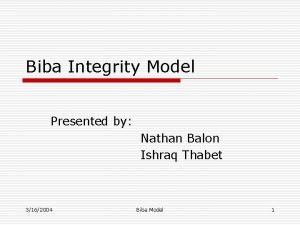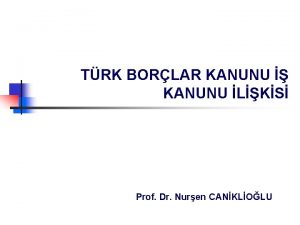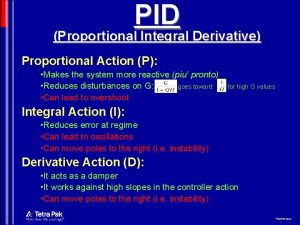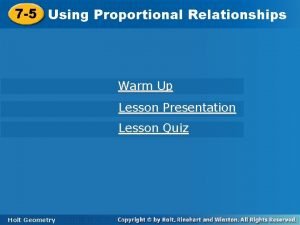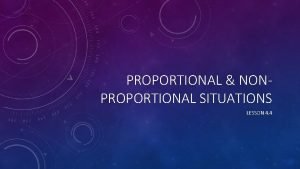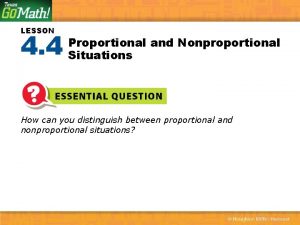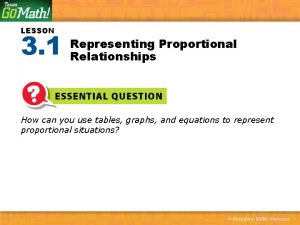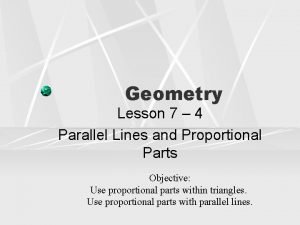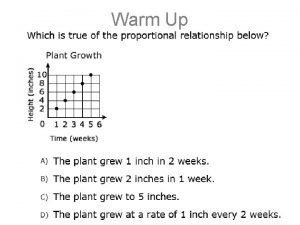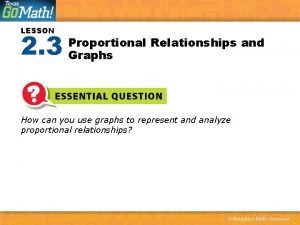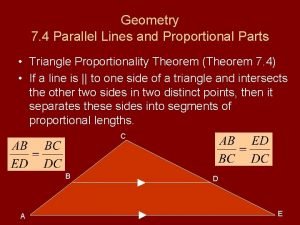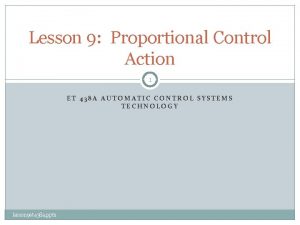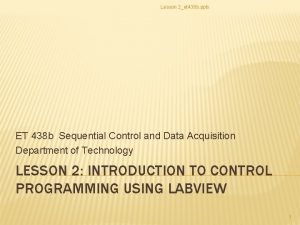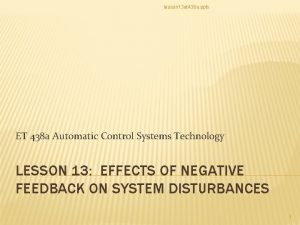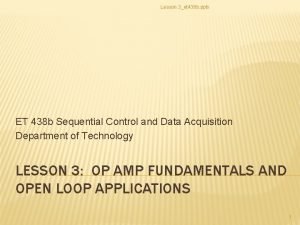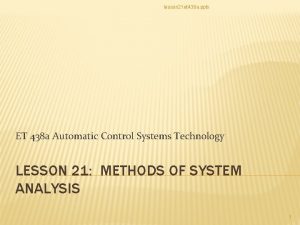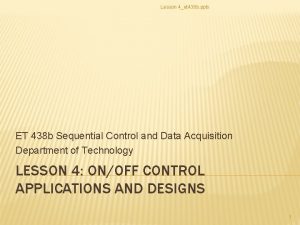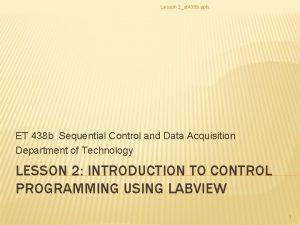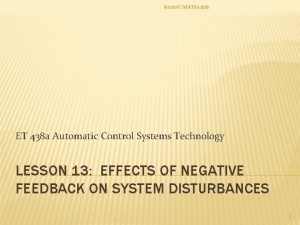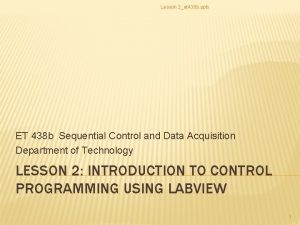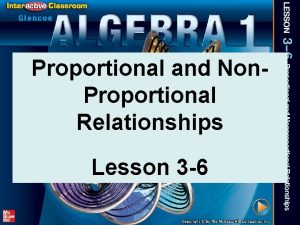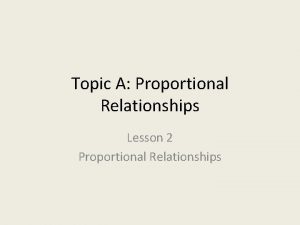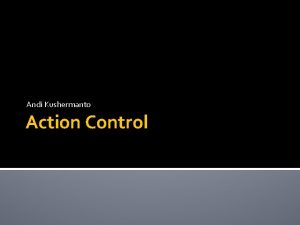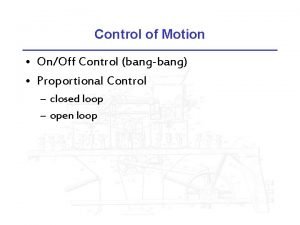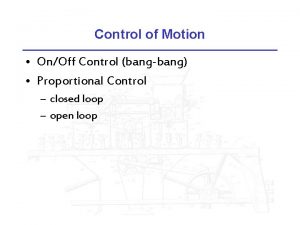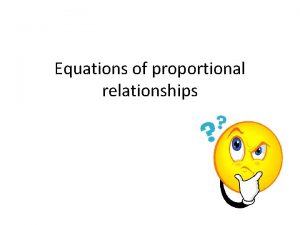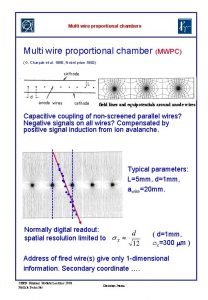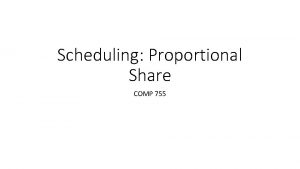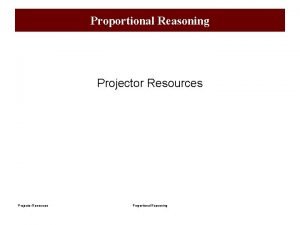Lesson 9 Proportional Control Action 1 ET 438






















- Slides: 22

Lesson 9: Proportional Control Action 1 ET 438 A AUTOMATIC CONTROL SYSTEMS TECHNOLOGY lesson 9 et 438 a. pptx

Learning Objectives 2 After this presentation you will be able to: Ø Ø Ø Identify the components of a proportional feedback control system. Write a mathematical model for a proportional controller. Compute the proportional bandwidth of a proportional controller. Explain the relationship between steady-state error and proportional gain. Perform lab experiment 2 more effectively. lesson 9 et 438 a. pptx

Proportional Control Action 3 Simplest form of controller - amplify error and apply signal to the process through final control element. Manipulated variable Basic control loop Setpoint value + Error - Controller Signal Conditioning lesson 9 et 438 a. pptx Final Control Element Sensor(s) Controlled variable Process (Plant)

Proportional Control Action 4 Example: Dc Motor Speed Control Dc Supply Control Voltage Desired Speed Error + - Controller Signal Conditioning lesson 9 et 438 a. pptx Variable Dc Supply Speed Transducer Motor Armature Voltage Dc Motor Shaft Speed

Proportional Control Math Relationship 5 Amplify error and send to final control element. Co = K p e + C b Where Co = the controller output Cb = the controller output with e =0 Kp = the proportional gain e = the control error e = SP - Measurement, e can be positive or negative. Error used to take corrective action e = error signal SP = setpoint value Measurement = sensor measurement lesson 9 et 438 a. pptx

Proportional Control Action 6 Measurement > SP e negative - output decrease SP Error=e + Co = K p e + C b - negative Measurement < SP e positive - output increase positive Co = K p e + C b lesson 9 et 438 a. pptx

Controller Output Limits 7 Practical controller output devices have limits on Co and final control element. Examples: flow value position, motor power supply -e lesson 9 et 438 a. pptx e Proportional band sets limits of control output. Determined by value of Kp.

Controller Output Limits 8 At higher Kp, e produces more correction but reduces the range between controller limits Vo +15 K 1>K 2>K 3 K 2 K 3 K 1 Verror Band increases as gain decreases -15 Proportional Band lesson 9 et 438 a. pptx

Computing Proportional Band Kp 9 Proportional gain - change in output /change in error Increasing proportional gain decreases proportional band (PB). In terms of percent: %PB inversely proportional to Kp lesson 9 et 438 a. pptx

Proportional Control Action 10 Example 9 -1: A proportional controller uses an OP AMP with ± 15 Vdc output limits when the error input is ± 3 Vdc. Saturation of the OP AMP sets these limits. Find the proportional gain and the percent proportional bandwidth from this information. Determine the proportional band max output if Kp=2. Find Kp by using Find the %PB 20% change in error gives maximum change in output lesson 9 et 438 a. pptx

Example 9 -1 Solution 11 Now set the value of proportional gain to 2 and compute the %PB and output Lower gain allows the OP AMP to handle more error before saturation. lesson 9 et 438 a. pptx

Characteristics of Proportional Control 12 Control formula Vo = Kp∙e + Vb Vo +15 V Kp(e) Bias, Vb Vb 0 V If e = 0, then Vo = Vb Kp 0 0. 1 e There is a band of steady-state error about 0 with magnitude of PB% where the output is not saturated. lesson 9 et 438 a. pptx If e≠ 0, then every unit of error produces Kp(e) units of correction that is added/subtracted to Vo.

Control Offset and Residual Error 13 Proportional control always produces a steady-state or residual error when a change in the process load occurs. (When e≠ 0) Vo +15 V Load Change e=0 Increasing Kp decreases steady-state error be can not eliminate it. Vb 0 V Kp e Residual Error lesson 9 et 438 a. pptx Permanent load changes produce permanent error. For transient load changes, the error returns to bias value, 0.

Increased Gain & Residual Error 14 High gain reduces steady-state error but increases chances of instability Example 9 -2: A proportional controller with a gain of 2 has an output range of 0 -15 Vdc for an error input range of 0 to ± 1 Vdc. The output has a balance value of 7. 5 Vdc. Determine: a. ) controller output when error is zero, b. ) residual error when a process load change produces and an error voltage of -0. 25 Vdc, c. ) residual error when control gain increases to 5. lesson 9 et 438 a. pptx

Example 9 -2 Solution (1) 15 For Kp=2, Vo=Co=0 -15 Vdc, and Ve=e= 0 to ± 1 Vdc. Also Vb=Cb=7. 5 Vdc. Ans Process load change produces… No residual error (Steady-state error) Find residual error…. Ans lesson 9 et 438 a. pptx

Example 9 -2 Solution (2) 16 For residual (stead-state) error to reach 0, Kp must increase to infinity. Set Kp=5 and compute new residual error Residual or steady-state error decreases inversely as the proportional gain increases lesson 9 et 438 a. pptx

Error As a Function of Proportional Gain 17 Computing residual error Where: SSd = desired steady-state output (1 for unit step) SSa = actual output at steady-state %_error= percentage of residual error based on desired value. Plot the change in residual error as the proportional gain increases using a typical control system lesson 9 et 438 a. pptx

Error As a Function of Proportional Gain 18 Low values of Kp produce high residual error lesson 9 et 438 a. pptx

Model of Proportional System (Bias = 0) 19 Block Diagram x(t) e(t) + Setpoint - Cb =0 + Kp + Plant t = RC r(t) Kd x(t) = input function Kp = Proportional controller gain Plant is modeled using RC circuit r(t) = output response of the control system Kd = feedback gain (voltage divider in lab) lesson 9 et 438 a. pptx Controller

Proportional System Time Response 20 Method of solution: Signal flow algebra and Laplace transforms Final solution to step change input: Kp affects response speed Kp affects final value Plot the response of this system to a step input (0 -1) for several values of proportional gain and compare them based on response speed and residual error. lesson 9 et 438 a. pptx

Proportional System Time Response 21 Comparison of response time and residual errors lesson 9 et 438 a. pptx

End Lesson 9: Proportional Control Action 22 ET 438 A AUTOMATIC CONTROL SYSTEMS TECHNOLOGY lesson 9 et 438 a. pptx
 Proportional control action
Proportional control action Nonproportional table
Nonproportional table Non proportional relationship
Non proportional relationship Inversely proportional
Inversely proportional Identifying graphs worksheet
Identifying graphs worksheet Indirectly proportional
Indirectly proportional Example of proportional relationship
Example of proportional relationship Fluke 438 motor analyzer
Fluke 438 motor analyzer Cs 438 uiuc
Cs 438 uiuc Advantages and disadvantages of biba model
Advantages and disadvantages of biba model 438 days
438 days Tbk 438/3 haksız fesih tazminatı
Tbk 438/3 haksız fesih tazminatı Pid in mechatronics
Pid in mechatronics Using proportional relationships worksheet
Using proportional relationships worksheet Lesson 4-4 proportional and nonproportional situations
Lesson 4-4 proportional and nonproportional situations Proportional and nonproportional situations
Proportional and nonproportional situations Representing proportional relationships lesson 3-1
Representing proportional relationships lesson 3-1 Parallel lines and proportional parts
Parallel lines and proportional parts Lesson 10 interpreting graphs of proportional relationships
Lesson 10 interpreting graphs of proportional relationships Lesson 2 proportional relationships
Lesson 2 proportional relationships Proportional parts in triangles and parallel lines
Proportional parts in triangles and parallel lines Medias res
Medias res Hatchet plot diagram answer key
Hatchet plot diagram answer key
